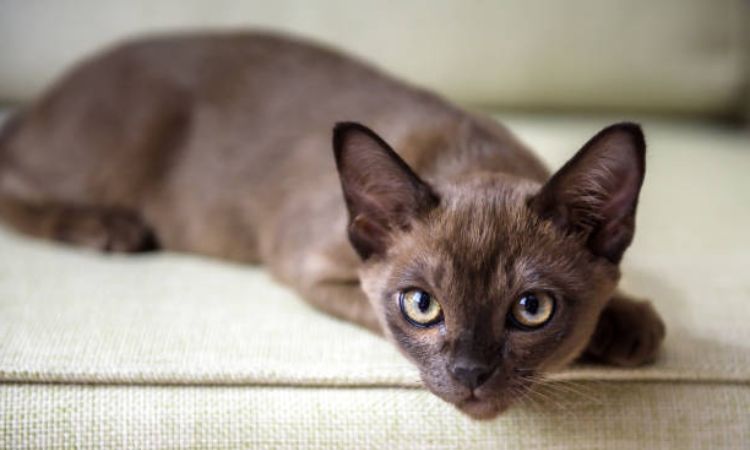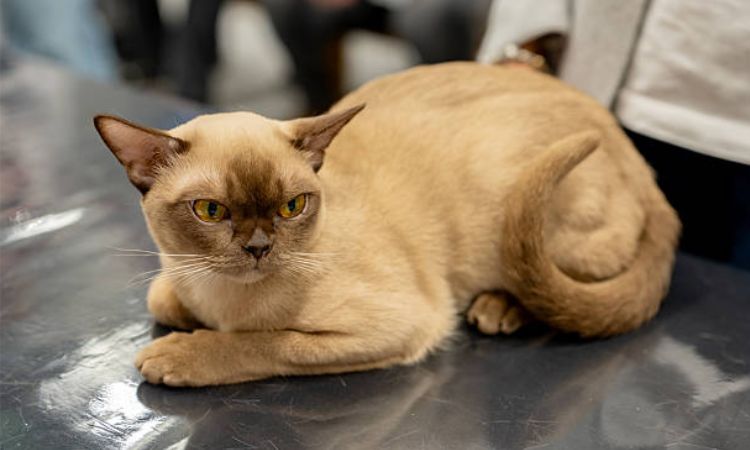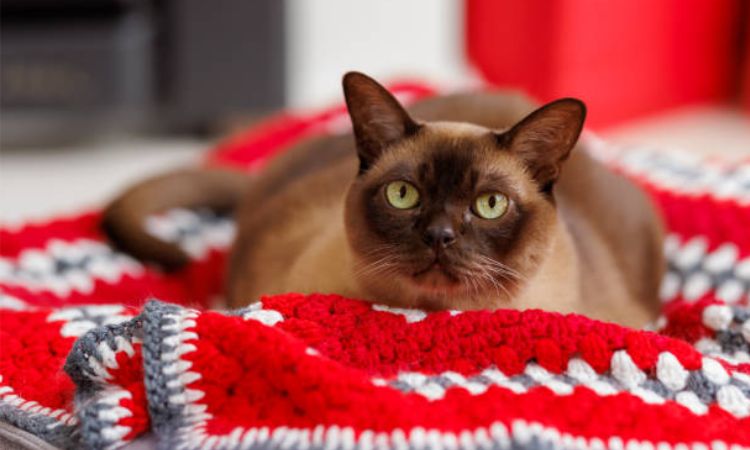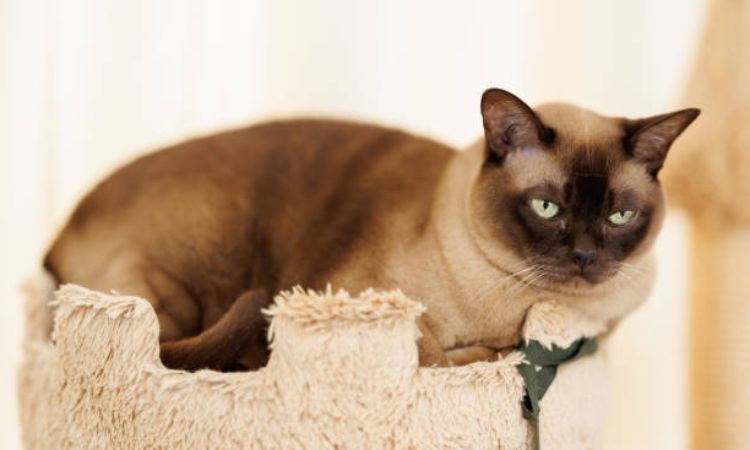Burmese cats are more than just beautiful pets—they’re lively, affectionate companions with a personality as striking as their golden eyes. Known for their silky coats in a variety of shades and their playful, people-oriented nature, they’ve been winning hearts for nearly a century.
Whether curled up in your lap or chasing after a favorite toy, Burmese cats bring warmth and energy to every home. In this guide, we’ll explore their unique traits, lifespan, and the many colors that make this breed so captivating.
Introduction to the Burmese Cat Breed

Brief Overview of the Breed
The Burmese cat is a distinctive and beloved domestic breed known for its muscular yet compact build, often described as feeling like “a brick wrapped in silk” when held. Originating from Burma and later developed in both the United States and the United Kingdom, the breed is admired for its affectionate, playful, and almost dog-like personality.
Burmese cats form strong bonds with their owners, often following them from room to room, eagerly engaging in games such as fetch, and maintaining a kitten-like energy well into adulthood. Their persistent but sweet vocalizations, combined with their deep need for companionship, make them a people-oriented breed that thrives on human interaction.
American vs. European (British) Burmese
Despite sharing the same origins, the Burmese breed diverged into two distinct types as breeding programs developed in the U.S. and the U.K.
- Body Type:
- The American (Contemporary) Burmese has a noticeably stockier and more muscular body, with a broad head, round eyes, and a short, wide muzzle.
- The European (British/Traditional) Burmese is more slender, featuring a wedge-shaped head, large pointed ears, almond-shaped eyes, and a longer, more tapered muzzle and limbs.
- Color Standards:
- The CFA (Cat Fanciers’ Association) in the United States recognizes four main coat colors: sable (dark brown), blue, chocolate (“champagne”), and lilac (“platinum”).
- The GCCF (Governing Council of the Cat Fancy) in the U.K. allows a wider palette, including brown, blue, chocolate, lilac, red, cream, and tortoiseshell variations.
- Other international registries vary in their recognition, but overall, British Burmese are accepted in more color ranges than their American counterparts.
Burmese Cat Physical Characteristics

Size and Weight
Burmese cats are considered a medium-sized breed, but their compact, muscular build makes them feel heavier than they appear—often described as “a brick wrapped in silk.” Adult Burmese typically weigh between 8–12 lbs (3.5–5.5 kg), with males tending toward the upper end of the range and females slightly lighter. Despite their smaller frame, they are sturdily built, with strong bone structure and well-developed muscles, giving them both agility and surprising strength. Their body is stocky yet graceful, making them excellent climbers and jumpers.
Coat and Grooming
One of the Burmese cat’s most striking features is its short, fine, satin-like coat. The fur is glossy and smooth, with a soft texture that feels silky to the touch. While Burmese kittens may display faint darker shading on the points of their coat, this typically disappears with age, revealing the rich, uniform color of their adult coat.
Accepted coat colors vary between regions but commonly include:
- Traditional/European: sable (deep brown), chocolate, blue, lilac, red, cream, fawn, and tortoiseshell.
- American: sable, champagne (chocolate), blue, and platinum (lilac).
Burmese cats are low shedders and have minimal grooming needs. Weekly brushing is generally sufficient to remove loose hairs and maintain coat health, though they often enjoy the bonding experience of grooming with their owners. The short coat also means bathing is rarely necessary, and overall, the breed is considered easy to care for in terms of grooming.
Eye Color
Burmese cats are known for their striking, expressive eyes, which are typically gold or yellow, depending on the individual and coat color. Their eyes are large, round, and vividly colored, contributing to the breed’s alert and inquisitive appearance. The combination of their expressive eyes and rounded facial features reinforces the breed’s endearing, affectionate look, perfectly complementing their playful and people-oriented personality.
Burmese Cat Colors and Patterns
The Four Core American Burmese Colors
The Cat Fanciers’ Association (CFA) officially recognizes four primary colors for the American Burmese:
- Sable (Dark Brown) – The classic and most traditional Burmese color. Sable cats have rich chocolate tones, darker along the back and tail, gradually fading to a warm, coffee-colored underbelly. Kittens often appear lighter, darkening as they mature.
- Champagne (Warm Beige/Chocolate) – A soft honey-toned coat that blends into slightly darker shades on the face, ears, paws, and tail. This color produces a warm, gentle look and is lighter on the underbelly and chest.
- Blue (Medium Gray with Fawn Undertones) – Blue Burmese are highly prized for their subtle gray-blue coat, sometimes with hints of periwinkle. The color is evenly distributed, darkening slightly at the tail, and pairs beautifully with green or gold eyes.
- Platinum (Light Gray/Lilac with Pink Tints) – The palest of Burmese colors, platinum cats have a silvery-gray coat with delicate pink undertones. Unlike champagne, their faces lack darker points, giving a soft, ethereal appearance.
European Burmese Colors and Tortoiseshells
European (British) Burmese exhibit a wider range of recognized colors, reflecting decades of selective breeding:
- Lilac – A soft lavender-gray variant with subtle purplish tones on the face, ears, and tail.
- Fawn – A muted beige similar to champagne but usually with darker facial markings.
- Red – A warm, rusty hue with lighter underparts and a coppery overlay on the back, ears, tail, and paws.
- Cream – Very pale, almost platinum, often with pink noses and subtle facial lines.
- Chocolate – Rich ash-brown with a smooth gradient darkening along the back, tail, and extremities.
- Cinnamon – A warm, sandy shade with faint rusty speckles and characteristic forehead markings.
- Tortoiseshell (Tortie) – Unique for combining two or more colors (commonly red and black) without any white. Almost all torties are female, making male torties extremely rare and highly prized.
Burmese cats’ color variations not only make them visually striking but also reflect the breed’s rich history and genetic diversity. From the classic sable to the rare tortoiseshell, each cat embodies the elegance, charm, and playful spirit that make Burmese cats so beloved worldwide.

Burmese Cat Personality and Temperament
Burmese cats are intelligent, affectionate, and playful—often described as having a “puppy-like” personality. Their curiosity and energy make them excellent family companions, and they love interacting with people. Many enjoy climbing to high vantage points, like shelves or even their owner’s shoulders, to observe their surroundings.
These cats are social and trusting, forming strong bonds with their families. They often follow their humans around, seeking attention and affection. With proper socialization, Burmese can get along with other cats, especially siblings or carefully introduced companions.
Highly playful, they require interactive toys and mental stimulation to stay happy. Their affectionate nature also makes them great with children, provided kids know how to respect their space.
While Burmese cats share some similarities with the Birman, they are a distinct breed with unique traits and a charming, lively personality that makes them a standout in any household.
Burmese Cat Lifespan and Health
Average Burmese Cat Lifespan
Burmese cats are generally a healthy breed, with an average lifespan of 10 to 17 years. Some individuals may live longer with proper care. Several factors can influence their longevity, including:
- Living environment: Indoor-only cats tend to live longer due to reduced exposure to accidents, infections, and predators.
- Diet and nutrition: Feeding a balanced, life-stage-appropriate diet helps maintain a healthy weight and reduces risks of obesity-related conditions, such as diabetes.
- Regular veterinary care: Routine check-ups, vaccinations, and preventative treatments contribute to a longer, healthier life.
- Genetics and responsible breeding: Choosing a Burmese from reputable breeders with tested bloodlines can minimize the risk of hereditary diseases.
Common Health Issues and Genetics
While Burmese cats are generally robust, they are predisposed to certain genetic and breed-specific health conditions:
Familial Episodic Hypokalemic Polymyopathy
- A genetic disorder causing muscle weakness, often affecting the neck and limbs.
- Symptoms usually appear within the first year of life and may include difficulty holding the head upright or walking.
- Managed through potassium supplementation, and genetic testing of breeding cats can help prevent affected kittens.
Diabetes Mellitus
- Burmese cats have an increased risk of developing diabetes, with estimates up to 10% affected.
- Symptoms include weight loss, increased thirst and urination, changes in appetite, lethargy, and vomiting.
- Management may involve diet modification, weight control, and insulin therapy.
Feline Orofacial Pain Syndrome (FOPS)
- Causes bouts of pain in the cat’s face and mouth, often triggered by eating, grooming, or opening the mouth.
- While incurable, pain management can improve quality of life.
Other potential conditions
- Obesity: Burmese cats are naturally stocky, so monitoring body condition is essential.
- Glaucoma: Less common, but regular eye exams are recommended.
- Congenital hypotrichosis and gangliosidosis: Breed-specific genetic conditions that responsible breeders can screen for.

Care and Prevention
Maintaining a Burmese cat’s health and longevity relies on proactive care:
- Regular veterinary visits: Routine check-ups help detect early signs of health problems, monitor weight, and administer vaccinations.
- Genetic screening and responsible breeding: Ensures kittens are not at risk for inherited conditions such as hypokalemic polymyopathy or FOPS.
- Diet and weight management: Feed age-appropriate, high-quality cat food in measured portions; avoid free-feeding.
- Exercise and enrichment: Playtime and interactive toys help maintain muscle tone, mental health, and a healthy weight.
- Observation and early intervention: Monitor for abnormal behavior, vocalization, changes in eating habits, or signs of discomfort, and seek veterinary care promptly.
With attentive care, Burmese cats can enjoy long, happy, and healthy lives, making them affectionate and loyal companions for many years.
Burmese cats are affectionate, playful, and intelligent companions that bring energy and warmth to any home. With their striking appearance, loyal nature, and manageable care requirements, they adapt well to families, apartments, or households with other pets. Understanding their unique personality, health needs, and grooming habits ensures a long, happy life for your Burmese, making them a truly rewarding feline friend.






